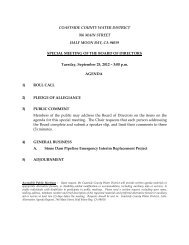Lower Pilarcitos Creek Groundwater Basin Study - Coastside ...
Lower Pilarcitos Creek Groundwater Basin Study - Coastside ...
Lower Pilarcitos Creek Groundwater Basin Study - Coastside ...
You also want an ePaper? Increase the reach of your titles
YUMPU automatically turns print PDFs into web optimized ePapers that Google loves.
uses. The computed decline in recharge is the result of increased impervious surfaces in<br />
the groundwater basin over the study period.<br />
Deep Percolation from Irrigation. Irrigation in the groundwater basin includes<br />
irrigation of crops and irrigation of landscaping. A portion of the water applied for<br />
irrigation of crops or landscaping percolates through the soil downward to recharge the<br />
groundwater basin. If the source of the irrigation is water imported from beyond the limits<br />
of the groundwater basin, then the deep percolation represents an inflow to the<br />
groundwater basin. If the irrigation source is local groundwater, then the deep<br />
percolation is not an inflow, but rather a return flow that simply recycles groundwater<br />
back into the basin.<br />
Two areas of cropland are irrigated primarily with sources of water beyond the<br />
groundwater basin. These include fields irrigated by diversions from Frenchmans <strong>Creek</strong><br />
on the north edge of the basin and fields that have been irrigated from Arroyo Leon on<br />
the south edge of the basin. These fields encompass an estimated 180 acres. Review of<br />
the soil moisture balance for landscaping and cropland (Appendix 7) indicates that the<br />
irrigation water required to supplement rainfall and fulfill the full potential ET is 16.70<br />
inches or 1.39 feet/year. It is assumed that irrigation efficiency is 85 percent; in other<br />
words, more water is applied than is actually needed by the crops. In addition, it is<br />
assumed that the surplus water percolates downward and does not run off the fields as<br />
surface water. Accordingly, the applied water amounts to 1.64 feet/year and the amount<br />
of deep percolation is 0.25 feet/year (1.64 -1.39). Application of this deep percolation<br />
rate to the 180 acres of irrigated cropland results in a deep percolation of 45 AFY.<br />
Landscape irrigation in the groundwater basin includes the irrigation of parks,<br />
playing fields, and landscaping around public buildings, businesses, apartment<br />
complexes, and homes. Some of this irrigation is provided by local groundwater;<br />
however, most of the landscape irrigation currently is supplied through the importation of<br />
CCWD water (primarily its Crystal Springs, <strong>Pilarcitos</strong> Lake, and upper <strong>Pilarcitos</strong> <strong>Creek</strong><br />
wellfield supplies).<br />
Information on the amount of water imported to the groundwater basin per se is<br />
not readily available. Accordingly, water imported to the groundwater basin has been<br />
estimated using available information on housing and water sales. First, the United<br />
States Census 2000 reports the existence of 4,004 occupied housing units in the City of<br />
Half Moon Bay, which extends to the north and south beyond the basin. With an<br />
estimated 1,000 homes beyond the groundwater basin boundaries, then approximately<br />
37



